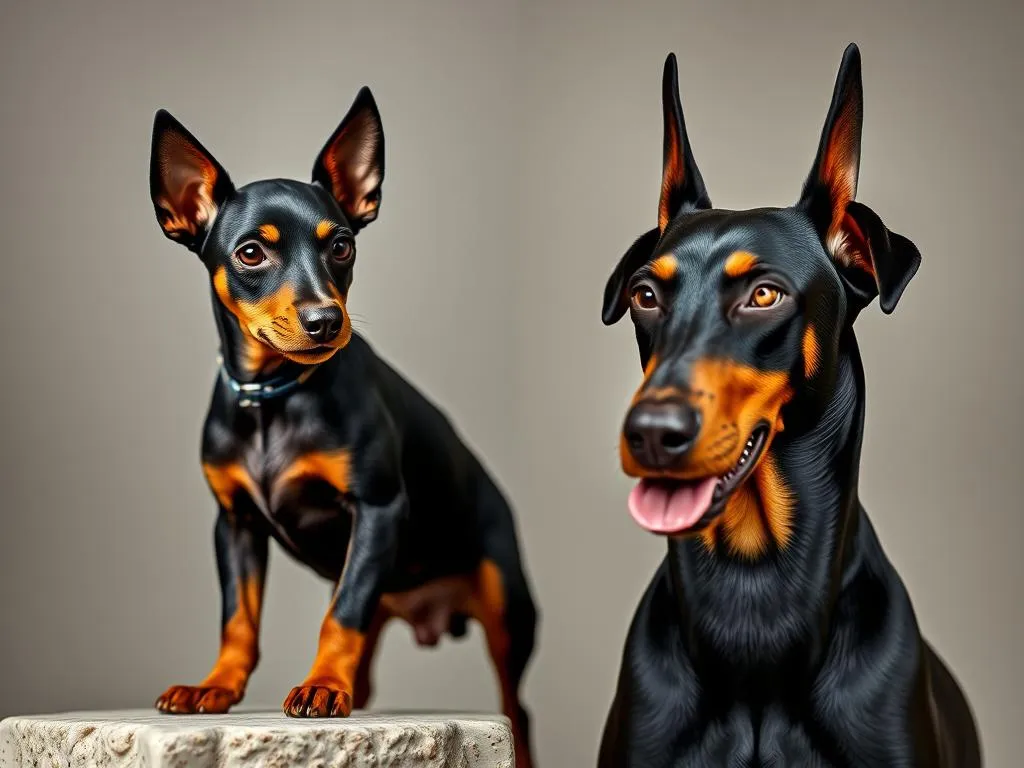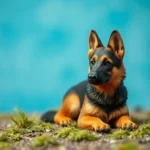
When it comes to choosing the right dog breed for your home, the Miniature Pinscher and the Doberman are two popular choices that often come to mind. Both breeds possess unique characteristics that can suit various lifestyles and preferences. Understanding the distinctions and similarities between these two breeds can help potential owners make informed decisions.
Breed Overview
Miniature Pinscher
The Miniature Pinscher, affectionately known as the “King of the Toys,” has a rich history that dates back to Germany. Originally bred to hunt vermin, this spirited little dog has earned its place as a beloved companion. Despite its name, the Miniature Pinscher is not a miniature version of the Doberman; rather, it is a distinct breed with its own lineage.
In terms of physical characteristics, the Miniature Pinscher typically stands between 10 to 12.5 inches tall and weighs around 8 to 12 pounds. Its short, smooth coat comes in a variety of colors, including black, chocolate, and red, often with rust markings. The breed is known for its elegant and athletic build, featuring a proud stance and high-stepping gait.
The temperament of the Miniature Pinscher is dynamic and spirited. These dogs are energetic, confident, and often described as fearless. They thrive on attention and can be quite affectionate with their families, but they also possess a stubborn streak that can make training challenging.
Doberman
The Doberman, on the other hand, is a larger breed that was developed in the late 19th century by a tax collector named Louis Dobermann in Germany. He aimed to create a loyal and protective dog to accompany him during his rounds. Over the years, the Doberman has evolved into a popular family pet and working dog, known for its intelligence and versatility.
In terms of size, Dobermans are significantly larger than Miniature Pinschers, standing between 24 to 28 inches tall and weighing anywhere from 60 to 100 pounds. They have a sleek, muscular build and a short coat that is typically black, blue, red, or fawn, often with rust markings.
The Doberman is renowned for its loyalty and protective instincts. This breed is intelligent, trainable, and often forms strong bonds with its family. While they are generally good with children, Dobermans also require socialization and consistent training to ensure balanced behavior.
Key Differences
Size and Appearance
The most apparent difference between the Miniature Pinscher and the Doberman lies in their size. The Miniature Pinscher, standing at a mere 10 to 12.5 inches, is a toy breed, while the Doberman towers at 24 to 28 inches. This size disparity not only affects their physical presence but also plays a role in their exercise needs and living arrangements.
Distinct physical features also set the two breeds apart. Miniature Pinschers have a more compact build and a characteristic high-stepping gait, whereas Dobermans boast a powerful, athletic physique. Additionally, Dobermans often have cropped ears and docked tails, contributing to their bold appearance, while Miniature Pinschers have naturally erect ears and long tails.
Temperament and Behavior
Both breeds exhibit unique temperaments that cater to different lifestyles. The Miniature Pinscher is known for its vivacious nature and can be quite mischievous. They are sociable and enjoy being the center of attention. However, their high energy levels can lead to destructive behavior if they do not receive sufficient exercise and mental stimulation.
In contrast, the Doberman is more reserved but fiercely loyal. They are protective of their families and can act as excellent watchdogs. While they are generally good with children, they require early socialization to ensure they are comfortable around other pets and strangers. Dobermans also tend to have moderate energy levels, requiring regular exercise to stay happy and healthy.
Health Considerations
Health is a critical aspect to consider when comparing breeds. Miniature Pinschers are generally healthy dogs, but they can be prone to certain conditions, such as patellar luxation and hip dysplasia. Their lifespan tends to be around 12 to 16 years.
Dobermans, while also robust, are more susceptible to specific health issues, including dilated cardiomyopathy (a heart condition) and von Willebrand disease (a bleeding disorder). Their lifespan is typically shorter, averaging 10 to 12 years, so potential owners should be aware of these health risks.
Training and Intelligence
Trainability
Both the Miniature Pinscher and the Doberman are intelligent breeds, but their trainability varies significantly. The Miniature Pinscher may be more challenging to train due to its independent nature and stubbornness. Positive reinforcement techniques, such as clicker training and treats, work best to motivate this breed.
Conversely, the Doberman is highly trainable and excels in obedience training. They respond well to structured training methods, and their eagerness to please makes them suitable for various roles, including service and therapy work. Early socialization and consistent reinforcement are crucial for both breeds to develop good behavior.
Intelligence Comparison
When it comes to intelligence, both breeds demonstrate significant problem-solving skills. However, the Doberman often outperforms the Miniature Pinscher in obedience tasks and dog sports. Dobermans are frequently seen in competitive settings, showcasing their agility and intelligence through various challenges.
Living Environment and Care
Ideal Living Conditions
Considering living conditions is essential when choosing between the Miniature Pinscher and Doberman. The Miniature Pinscher is adaptable and can thrive in apartment living, provided they receive ample exercise. They enjoy daily walks and playtime, but their small size means they do not require as much space as larger breeds.
On the other hand, the Doberman needs more room to roam and exercise. They are best suited to homes with large yards where they can run and play. While they can adapt to apartment living, their exercise needs are higher, so daily walks and playtime are necessary to keep them physically and mentally stimulated.
Grooming Needs
Both breeds have relatively low grooming requirements due to their short coats. The Miniature Pinscher sheds moderately and requires occasional brushing to remove loose hair. Bathing should be done sparingly, as overbathing can strip their coat of essential oils.
The Doberman also requires minimal grooming, but regular brushing can help reduce shedding. Owners should pay attention to their ears and teeth, ensuring they are clean and healthy. Both breeds are considered low-allergen options, making them suitable for allergy sufferers.
Cost of Ownership
Initial Costs
When considering the Miniature Pinscher vs Doberman, initial costs can vary. Miniature Pinschers typically cost between $800 to $2,500 depending on the breeder and lineage. Adoption from shelters or rescue organizations can reduce costs significantly.
Dobermans usually range from $1,500 to $3,000. Like the Miniature Pinscher, adopting from shelters or rescues can provide a more budget-friendly option. Initial supplies, including food, bedding, and toys, should also be factored into the budget for both breeds.
Ongoing Expenses
Ongoing expenses for both breeds include food, veterinary care, grooming, and supplies. Miniature Pinschers may require less food due to their size, averaging around $30 to $50 per month. Regular veterinary check-ups, vaccinations, and any potential health issues should also be considered in the budget.
Dobermans, being larger, will incur higher food costs, typically ranging from $50 to $100 monthly. Their potential health issues may also lead to increased veterinary expenses. Overall, both breeds require a commitment to ongoing care and financial responsibility.
Conclusion
In summary, the Miniature Pinscher and Doberman each bring unique qualities to the table. The Miniature Pinscher is a small, spirited companion, perfect for active individuals or families with older children. On the other hand, the Doberman is a loyal and protective breed suited for those seeking a larger, more active dog.
When deciding between the two, consider your living arrangements, lifestyle, and the level of commitment you can offer. Both breeds can make wonderful companions, but understanding their needs and behaviors is essential for a successful match.
FAQs
What is the average lifespan of each breed?
The average lifespan of a Miniature Pinscher is around 12 to 16 years, while Dobermans typically live for 10 to 12 years.
Are Miniature Pinschers good with children?
Miniature Pinschers can be good with older children but may not be suitable for very young kids due to their energetic and sometimes nippy nature. Supervision is recommended.
Do Dobermans require a lot of exercise?
Yes, Dobermans require regular exercise to stay healthy and happy. Daily walks and playtime are essential to meet their physical and mental needs.
How do I choose between a Miniature Pinscher and a Doberman?
Consider your living conditions, activity level, and personal preferences. If you want a smaller, more adaptable dog, the Miniature Pinscher may be a better fit. If you prefer a larger, protective breed, the Doberman could be the right choice.









